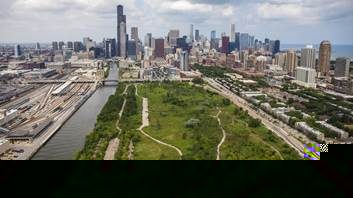 Nice weather has a small window in Chicago so we need to be prepared to take advantage of it. So why go to an indoor bar for your weekend plans? There are gems all across the city where you can sip a cocktail, indulge in an exquisite meal and enjoy the great outdoors with friends. When planning your night out, make sure these rooftop bars are on the top of your list.
Nice weather has a small window in Chicago so we need to be prepared to take advantage of it. So why go to an indoor bar for your weekend plans? There are gems all across the city where you can sip a cocktail, indulge in an exquisite meal and enjoy the great outdoors with friends. When planning your night out, make sure these rooftop bars are on the top of your list.
GreenRiver | 256 E Erie St.
Sitting atop an unlikely building, GreenRiver is on the 18th floor of the Northwestern Memorial Hospital office complex in Streeterville. Don’t let the location fool you, however. GreenRiver’s cocktail list boasts 32 modern libations. Each drink comes with a paragraph backstory about its old-world Irish name. On top of the history lesson, Chef Aaron Lirette has designed a menu filled with Midwestern fare sure to satisfy.
Streeterville Social | 455 N Park Dr.
Streeterville Social rests on the 3rd floor rooftop of the Loews Hotel. One of the more spacious options on the list, this rooftop oasis boasts 9000 square feet of green space populated with plenty outdoor couches and lawn games like cornhole and giant jenga offering a relaxed summer vibe. As for their drinks, many have a sweet-fruity vibe and they pair them with a small plates menu; an excellent recipe for a summer night.
Tanta Chicago | 118 W Grand Ave.
Tanta is a Peruvian influenced hot spot that lies in the heart of the River North neighborhood. Their rooftop terrace is an urban paradise and one of two bars on the property. Known for their Pisco Sour, all of their signature drinks offer a Peruvian flare for a unique combination. Don’t just come for a drink though. Chef Gaston Acurio, world renowned restaurateur, serves top notch authentic Peruvian dishes which will have you more cultured by the time you leave. If you are in River North you must start off the night with a Pisco Sour while taking in the rooftop views.
The J. Parker | 1816 N Clark St.
The J. Parker is one of the hottest spots in Lincoln Park, and with good reason. This rooftop bar offers one of the best views of Lincoln Park and the lake; that being said, the food and drinks might outdo the scenery. The cocktail list is full of destination based drinks from all over the globe and Chef Paul Virant has designed the perfect small plates menu to compliment the worldly drinks. Be sure to check it out!









 With top-notch Chicago real estate brokerage firms like Related Realty offering stunning residences with sprawling state-of-the-art kitchens, dining in is often a great option. For the last few months, a night out has meant huddling in a warm, cozy enclave and avoiding the outside whenever possible, and dining in often involved comfort foods such as soups and stews simmering on the stove. But those days are over now.
With top-notch Chicago real estate brokerage firms like Related Realty offering stunning residences with sprawling state-of-the-art kitchens, dining in is often a great option. For the last few months, a night out has meant huddling in a warm, cozy enclave and avoiding the outside whenever possible, and dining in often involved comfort foods such as soups and stews simmering on the stove. But those days are over now.


